The REMINGTON Model 37 "Rangemaster"
and 40-X .22RF TARGET RIFLES
Please be aware that some specialist imagery may take time to load.
This site is designed for dedicated researchers, and is best viewed on desktop.
See also: ......The Winchester Model 52 Rifles ...... - ......BSA & other Small-bore Target Rifles
Below, the early production Model 37 with fore-end barrel-band.
Only a few hundred were made before the shooting fraternity advised the removal of the barrel band to improve accuracy, effectively resulting in a free-floating barrel.
With significant numbers of these stocks already in store, they were trimmed back to behind the barrel band, so those rifles made with them appeared very short in the fore-end.
Subsequently the later purpose-made longer furniture afforded better aesthetic balance to the rifle.
The few prototypes to be seen are of similar configuration to the early rifle shown below, but with a hand-groove either side of the fore-end.
 image by courtesy of Dave Kern
image by courtesy of Dave Kern
The Remington company produced a large two-sided single-sheet leaflet that was folded as if into a small pamphlet. We have taken the variously orientated and sized printed sections and split them into a more easily readable PDF format with searchable text.
It was not long before the necessary amendment to the rifle's stocking required a similar adjustment to the advertising, the rifle also then becoming the "Rangemaster", a name that was retained through all the following iterations of the rifle,
The post 1939 production models had the fore-end extended to the length of the rifle in the image below.
Once civilian rifle shooting again became popular after the 1939-45 European War,
not until the Pacific War ended were manufacturers able to consider restarting
the production of civilian target rifles.
It was not until after 1947 that many such rifles became readily available in either the United States or Great Britain.
However, almost strangely for the time in which Great Britain was anticipating an invasion, and before the United States of America formally entered World War II,
(although it is well accepted in the U.K. that much was being done to help the war effort - with Lend-lease and other less well-known assistance),
the Society of Miniature Rifle Clubs were able to acquire a number of the Matchmaster (513) rifles, which were advertised in the December issue of their 1940 Journal "The Rifleman", with orders being taken at £8 per rifle for delivery the following February.
This was at a time when small-bore rifles of all types were being sought, with contracts being awarded to both Remington and particularly Winchester for the supply of such weapons mainly for Home Guard and Auxiliary use.
Post-War, Remington self-advertised their small-bore target rifles
in their own paper "Rifle News" early in 1949.

The similarity between the three rifles in the advertisement is marked,
and has occasionally led to some confusion when the rifles have been spoken of by the uninitiated.
The 'Rangemaster' is the Model 37, the 'Matchmaster' is the Model 513T, and the 521T was then un-named.
At that time, Remington wrote of these rifles, under the article heading
"REMINGTON RIFLES STAND OUT AS INDOOR SHOOTING ACTIVITIES BOOM"
"Veterans & Tyros praise Match performance of Remington models"
"Bridgeport, Connecticut, February 1949"
With one of the biggest indoor occasions ever recorded in full tilt,
the word is that Remington match rifles are prominent as ever on the firing lines.
Their consistent high scoring performance is drawing plenty of enthusiastic praise"
Model 37
A fine precision instument. Every part, every feature is planned to bring the utmost in hair-line accuracy. The "Miracle Trigger" is a favourite with shooters because of its smooth, sharp, crisp, lightning-fast let-off with no creep or backlash. Its single sighting plane lets you put your cheek against the same identical spot on the stock, no matter what type of sight you use.
Model 513T
A smooth handling, superb;y accurate rifle. This moderately priced model offers the shooter a heavy match barrel, target stock, micrometer sights, and the comfortable adjustable front sling swivel.
Model 521T
A sharp-shooting combination for target or field shooting. Popular priced, extremely easy to handle. The right rifle for the right start, ideally suited to the young rifleman. Self-cocking bolt and double locking lugs provide correct head-spacing. It has a corrugated trigger. And the separate sear provides smooth, crisp pull.
One hesitates to criticise such a successful company's advertising, particularly seventy years on,
but many of the points raised neither differentiate well between the three rifles,
nor bring up what potential purchasers may have seen as the most relevant features.
Some may even consider there to have been an overly obvious element of the blowing of Remington's own trumpet,
but opinions and outlook change with the times.
Below, the later production model 37, famously known as the "Rangemaster".
This particular rifle has been fitted with Parker-Hale target sights,
the rear-sight being specifically made, with its own mounting block,
to fit rifles imported and retailed by that company.
Further down the page we show the standard rifle
with its Remington fore-sight and Redfield rear-sight.
The next four images can be rotated and zoomed,
either as initially loaded or full-screen for higher definition.
And the rifle fitted with the then popular Unertl telescopic sight.
 ......................
...................... 
Initially introduced in 1937, and advertised post-WW2 in the Parker-Hale catalogue.

And again advertised in a U.S. journal in 1947

The rifle's model is clearly marked just forward of the rear telescope mounting block.

And the calibre on the left-hand-side just forward of the barrel's reinforce
on which the serial number is stamped.
The latter can be used to identify the date of manufacture,
and details for this are to be found online with a simple search.

Further forward, the barrel is stamped with the company address,
"REMINGTON ARMS CO. INC. ILION N.Y. MADE IN U.S.A."
"PATENT NUMBERS 2.005.866--2.007.019--2.126.350"
beneath which lies the company's name logo and
"REG. US. PAT OFF"
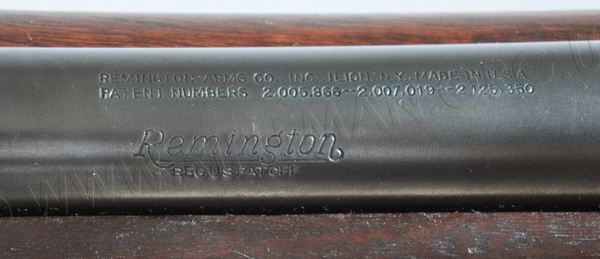
The various inspection and proof marks are on the opposite side to the calibre stamping,
and, in common with rifles brought into the U.K., it carries the requisite stamp
" NOT ENGLISH MAKE"
which has been heavily bounced in the striking.

The closed bolt is also clearly proof marked.

The chamber is shown at the front of the receiver,
with the loading platform in place.

The bolt-head is just visible in the bolt-way at the rear of the receiver,
and the grooved component at the rear of the magazine-way shows the small hole
into which a small rod or the head of a punch must be introduced
and pressed down whilst the trigger is pulled
in order that the bolt may be withdrawn.
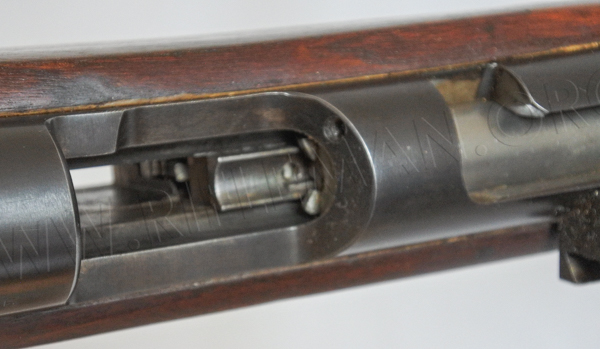
The base of the loading platform insert is flush with the front of the trigger-guard fitting,
as is the press-button for magazine release.

Left below: the unusual fitting under the front of the fore-end is a tell-tale sign
that this rifle was once fitted with an electric bedding system.
Details of a contemporary rifle still so configured can be found
on the page for the BSA Model 15 and Centurion rifles.
Right: the trigger adjustment screw.
 ........
........ 
Left: the Parker-Hale rear-sight mounting block,
and the safety catch set to 'ON'.
Right: the sear in the bolt-way with the bolt removed.
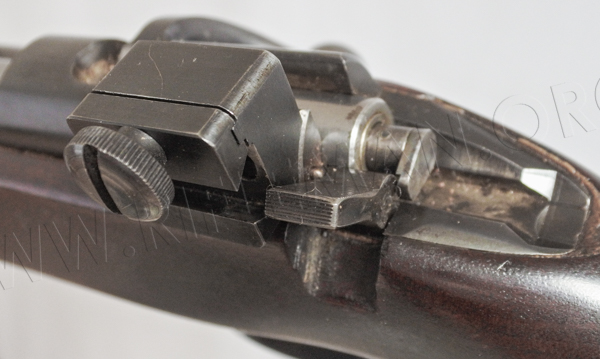 .....................
..................... 
Left, the Parker-Hale tunnel fore-sight, and
right: the specifically made Parker-Hale rear-sight.
 .........................
......................... 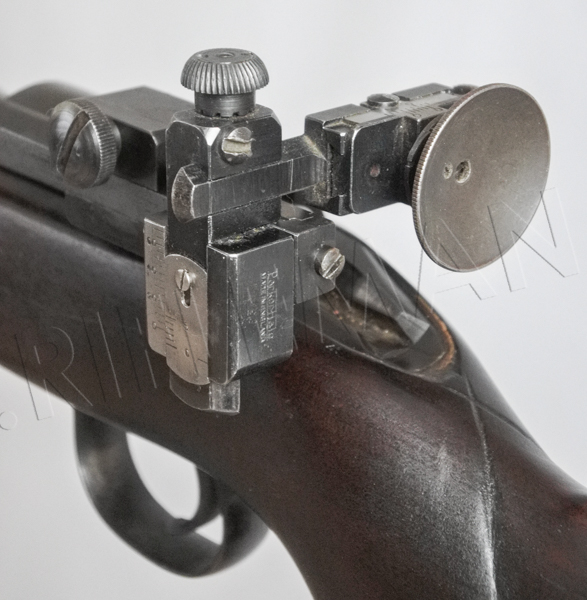
The bolt from below and above


The bolt-head face, showing the extractor and ejection levers.

The steel single-loading platform insert that can be interchanged
with Remington's 5-round magazine if so desired.
The spring-loaded ramp at the front of the platform helps guide a round into the chamber,
and is pushed down by the bolt-head on final closing of the bolt.
 ...............
............... 
The original purchaser of this rifle had experienced some problems,
and returned it to the National Small-bore Rifle Association,
from whose retail facility it had been bought, for inspection.
The letter-head notes that the N.S.R.A. was formerly the
Society of Miniature Rifle Clubs, which had been renamed
just over ten years earlier post WW2.


The rifle was returned, with no fault discovered,
and with the test groups shown below to confirm its capability.
The circumstances under which these were shot are explained in the accompanying letter above left.
The owner had obviously then written in reply stating his satisfaction,
as indicated by the N.S.R.A.'s relieved reply on the right,
also making the point that the rifle had , presumably in 1958,
been purchased from the Association second-hand.

The rifle was resold soon after, as the new owner, who had moved with it to Washington D.C.,
had evidently written to the U.S. National Rifle Association
with a query regarding the disassembly of the bolt.
This is unsurprising, as there was then no internet, and
nowadays there are many searches made enquiring how the bolt should be removed,
let alone how it can be taken apart!
It is one of very few small-bore target rifles for which
a tool is required to simply remove the bolt!
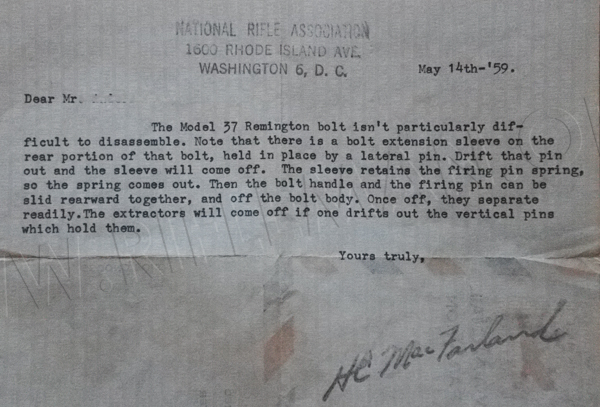
The Model 37 Rangemaster was updated to the 40-X
here advertised in the U.S. Stoeger Arms catalogue of 1957.

And shown here in a British National Small-bore Rifle Association advertisement - in 1963

In June of that same year, a brief article was published in the American Rifleman.
We are able to show the field manual and, beneath that,
the Parts list and schematic for the rifle.
You can view this facsimile full screen
You can view this facsimile full screen
............. the Rangemaster rifle was still available in the U.K. post 1965 - as the 40 XB

Below are 1963 prices for comparison with other rifles of the day.

The 40 XB was included in a 1965 write-up of contemporary .22RF target rifles in Guns Review magazine,
along with the BSA Martini International, Winchester 52, Anschutz and Walther equivalents of the day.
You can view this facsimile full screen
Return to: TOP of PAGE
See this website's Raison d'être



